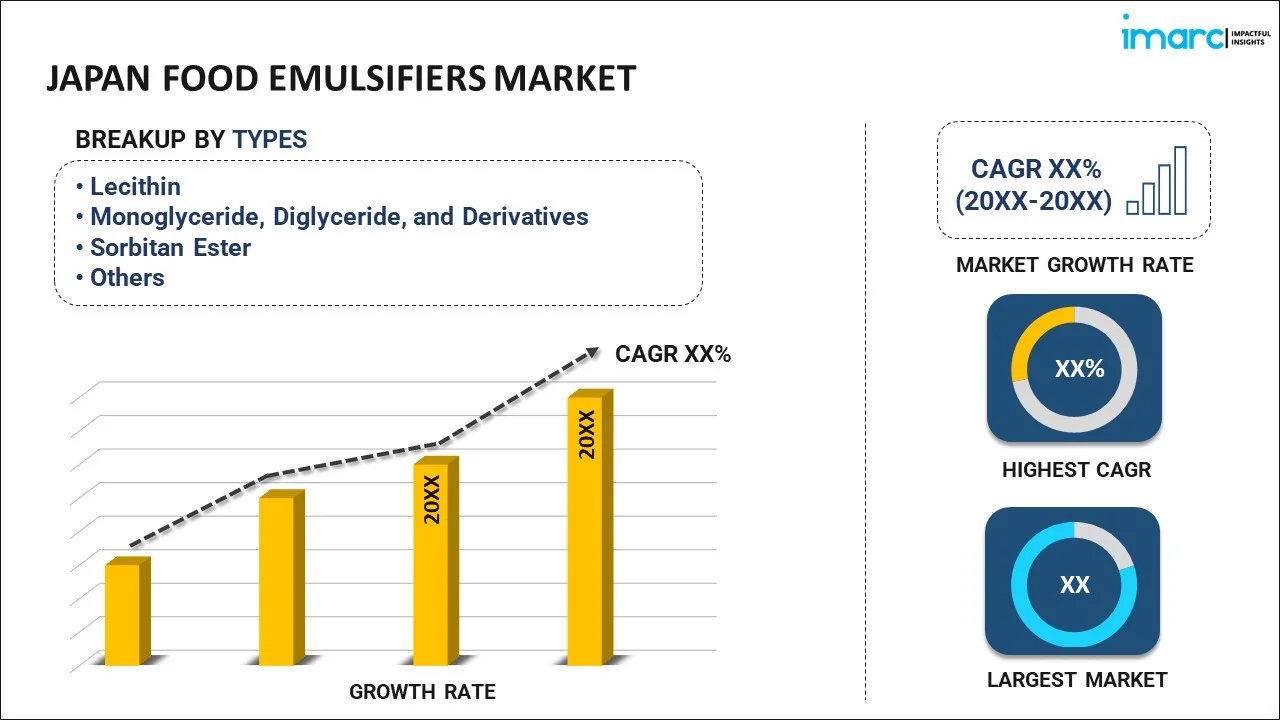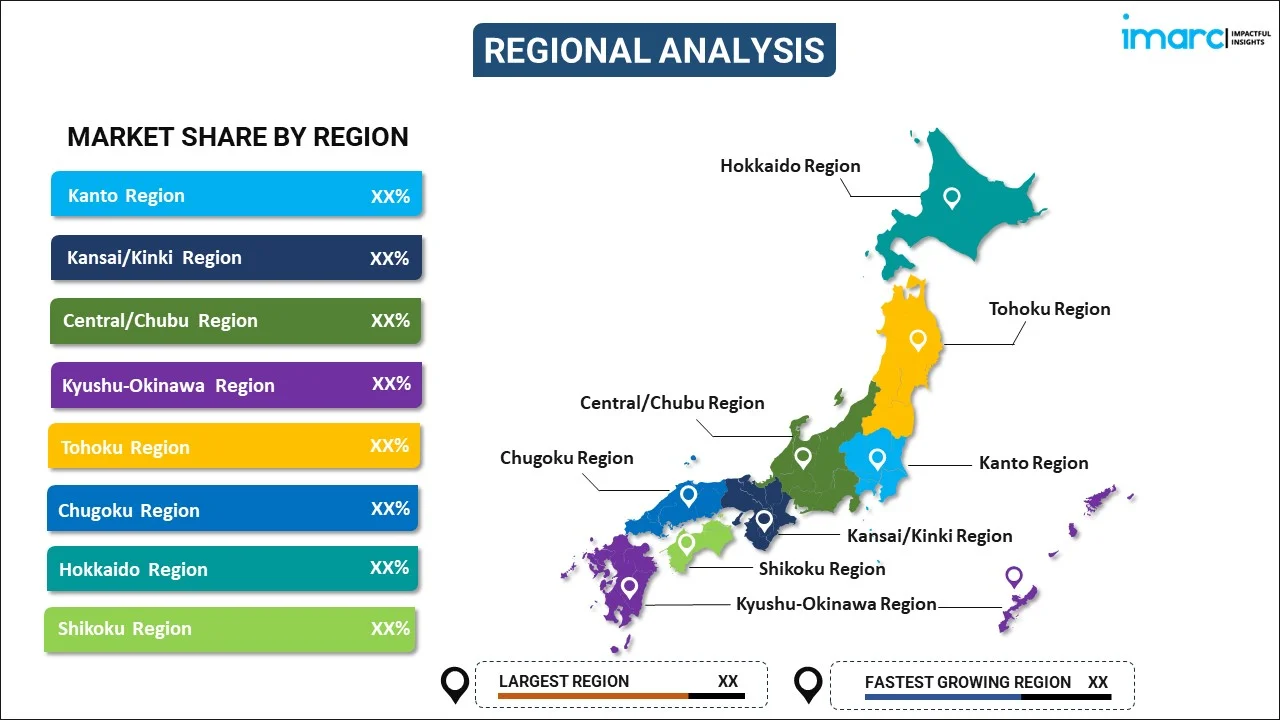
Japan Food Emulsifiers Market Report by Type (Lecithin, Monoglyceride, Diglyceride, and Derivatives, Sorbitan Ester, and Others), Application (Bakery, Confectionery, Dairy and Frozen Products, Meat, Poultry, and Seafood, Beverages, and Others), and Region 2025-2033
Market Overview:
Japan food emulsifiers market size reached USD 163.8 Million in 2024. Looking forward, IMARC Group expects the market to reach USD 256.7 Million by 2033, exhibiting a growth rate (CAGR) of 4.6% during 2025-2033. The increasing growth of small-scale craft food producers coupled with the rising demand for unique foods that address particular health concerns or lifestyle preferences is primarily driving the market growth.
|
Report Attribute
|
Key Statistics
|
|---|---|
|
Base Year
|
2024
|
|
Forecast Years
|
2025-2033
|
|
Historical Years
|
2019-2024
|
|
Market Size in 2024
|
USD 163.8 Million |
|
Market Forecast in 2033
|
USD 256.7 Million |
| Market Growth Rate 2025-2033 | 4.6% |
Food emulsifiers are substances that serve as bridges between conflicting elements like water and oil. They consist mainly of natural fats and synthetic ester compounds, and their primary function is to facilitate the blending of liquids that would otherwise resist mixing. Their significance lies in their ability to enhance the shelf life, texture, and overall quality of a wide range of food products, spanning from baked goods to dairy items, dressings, and beyond. By offering stability, food emulsifiers effectively prevent separation, enhance product uniformity, and contribute to a more pleasurable culinary experience. In the broader scope of the food industry, emulsifiers play a vital role not only in meeting consumer expectations but also in maintaining the integrity of complex food formulations. These versatile additives are indispensable tools for food technologists and chefs alike, allowing them to create products that meet the high standards of modern cuisine while ensuring that ingredients with contrasting properties come together harmoniously.
Japan Food Emulsifiers Market Trends:
The food emulsifiers market in Japan is experiencing a significant surge driven predominantly by the heightened awareness among consumers regarding the quality and safety of food products. This heightened awareness has prompted the food industry to adhere to more rigorous regulations concerning food additives, pushing them towards the adoption of certified and efficient emulsifiers. Furthermore, the continuous progress in food science and technology is facilitating the creation of emulsifiers that are not only more effective but also healthier, propelling market growth. Apart from this, the increasing population in Japan and its corresponding demand for processed foods have created a need for emulsifiers capable of extending product shelf life and enhancing texture. Simultaneously, the growing preference for clean-label and natural ingredients is inspiring manufacturers to innovate in this domain. Moreover, the expansion of the food and beverage sector, along with the ongoing shift in consumer preferences towards ready-to-eat meals, is expected to drive the food emulsifiers market in Japan during the forecast period.
Japan Food Emulsifiers Market Segmentation:
IMARC Group provides an analysis of the key trends in each segment of the market, along with forecasts at the country level for 2025-2033. Our report has categorized the market based on type and application.
Type Insights:

- Lecithin
- Monoglyceride, Diglyceride, and Derivatives
- Sorbitan Ester
- Others
The report has provided a detailed breakup and analysis of the market based on the type. This includes lecithin, monoglyceride, diglyceride, and derivatives, sorbitan ester, and others.
Application Insights:
- Bakery
- Confectionery
- Dairy and Frozen Products
- Meat, Poultry, and Seafood
- Beverages
- Others
A detailed breakup and analysis of the market based on the application have also been provided in the report. This includes bakery, confectionery, dairy and frozen products, , meat, poultry, and seafood, beverage, and others.
Regional Insights:

- Kanto Region
- Kansai/Kinki Region
- Central/ Chubu Region
- Kyushu-Okinawa Region
- Tohoku Region
- Chugoku Region
- Hokkaido Region
- Shikoku Region
The report has also provided a comprehensive analysis of all the major regional markets, which include Kanto Region, Kansai/Kinki Region, Central/ Chubu Region, Kyushu-Okinawa Region, Tohoku Region, Chugoku Region, Hokkaido Region, and Shikoku Region.
Competitive Landscape:
The market research report has also provided a comprehensive analysis of the competitive landscape. Competitive analysis such as market structure, key player positioning, top winning strategies, competitive dashboard, and company evaluation quadrant has been covered in the report. Also, detailed profiles of all major companies have been provided.
Japan Food Emulsifiers Market Report Coverage:
| Report Features | Details |
|---|---|
| Base Year of the Analysis | 2024 |
| Historical Period | 2019-2024 |
| Forecast Period | 2025-2033 |
| Units | Million USD |
| Scope of the Report | Exploration of Historical and Forecast Trends, Industry Catalysts and Challenges, Segment-Wise Historical and Predictive Market Assessment:
|
| Types Covered | Lecithin, Monoglyceride, Diglyceride, and Derivatives, Sorbitan Ester, Others |
| Applications Covered | Bakery, Confectionery, Dairy and Frozen Products, Meat, Poultry, and Seafood, Beverages, Others |
| Regions Covered | Kanto Region, Kansai/Kinki Region, Central/ Chubu Region, Kyushu-Okinawa Region, Tohoku Region, Chugoku Region, Hokkaido Region, Shikoku Region |
| Customization Scope | 10% Free Customization |
| Post-Sale Analyst Support | 10-12 Weeks |
| Delivery Format | PDF and Excel through Email (We can also provide the editable version of the report in PPT/Word format on special request) |
Key Questions Answered in This Report:
- How has the Japan food emulsifiers market performed so far and how will it perform in the coming years?
- What has been the impact of COVID-19 on the Japan food emulsifiers market?
- What is the breakup of the Japan food emulsifiers market on the basis of type?
- What is the breakup of the Japan food emulsifiers market on the basis of application?
- What are the various stages in the value chain of the Japan food emulsifiers market?
- What are the key driving factors and challenges in the Japan food emulsifiers?
- What is the structure of the Japan food emulsifiers market and who are the key players?
- What is the degree of competition in the Japan food emulsifiers market?
Key Benefits for Stakeholders:
- IMARC’s industry report offers a comprehensive quantitative analysis of various market segments, historical and current market trends, market forecasts, and dynamics of the Japan food emulsifiers market from 2019-2033.
- The research report provides the latest information on the market drivers, challenges, and opportunities in the Japan food emulsifiers market.
- Porter's five forces analysis assist stakeholders in assessing the impact of new entrants, competitive rivalry, supplier power, buyer power, and the threat of substitution. It helps stakeholders to analyze the level of competition within the Japan food emulsifiers industry and its attractiveness.
- Competitive landscape allows stakeholders to understand their competitive environment and provides an insight into the current positions of key players in the market.
Need more help?
- Speak to our experienced analysts for insights on the current market scenarios.
- Include additional segments and countries to customize the report as per your requirement.
- Gain an unparalleled competitive advantage in your domain by understanding how to utilize the report and positively impacting your operations and revenue.
- For further assistance, please connect with our analysts.
 Inquire Before Buying
Inquire Before Buying
 Speak to an Analyst
Speak to an Analyst
 Request Brochure
Request Brochure
 Request Customization
Request Customization




.webp)




.webp)












